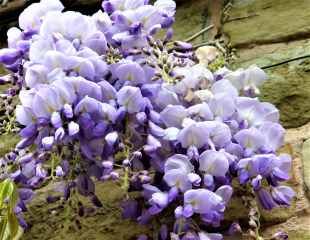
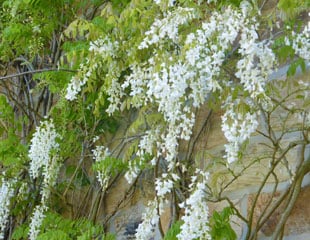
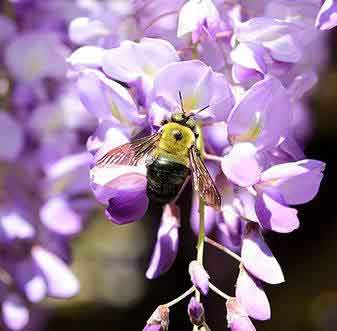
How Plant, Grow and care for Wisteria
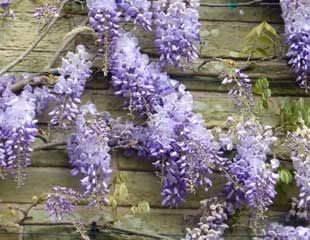
Growing Wisteria Key Points
- A very vigorous, deciduous, climbing plant.
- Highly scented showy blooms in April, May & June.
- Requires strong support system of wires/trellis.
- High maintenance "red Wheelbarrow plant"
- Needs to be pruned twice a year, February and August
Wisteria is a deciduous, twining climbing plant with a long flowering period and highly scented blooms. A Wisteria in bloom is a magnificent sight with long, trailing scented blooms in either blue, purple, pink or white. Traditionally, Wisteria is grown on a south-facing wall. Wisteria floribunda (which twines clockwise) is originally from Japan, and w. sinensis (twines anti clockwise) is from China and is the more vigorous of the two. On W. senensis, the flowers appear before foliage, and on W.floribunda flowers and foliage come out at the same time.
Most Wisteria are fast-growing and vigorous, reaching up to 9 meters (30ft). It is not self-supporting and requires a framework of wires or supports to grow up. It is best to put the framework in place before planting Wisteria. Although Wisteria grows well in full sun, it will also tolerate light shade.
The plus side of growing Wisteria is its wonderful, long scented blooms. But before planting a Wisteria, it is best to know the downsides of growing Wisteria. I have labelled (one of the few on this website) a red wheelbarrow plant. In summary, Wisteria can be tricky to get to flower; once flowering, it needs to be pruned twice a year to keep it in check and to continue flowering each year. Once it gets large, pruning can involve climbing ladders. Early severe frost can spoil its blooms, and it drops a lot of leaves in the autumn.
It is also vigorous; some varieties grow at a rate of 2m+ or 10ft per annum. It can (and must) be pruned to manage its growth, and still needs a large space. It may sound obvious, but Wisteria is best planted in the right place from the outset. This is because it forms a very strong, woody root and is hard to remove once established.
If you are looking for a smaller variety, the best one to check out is Wisteria frutescens 'Amethyst Falls' which grows to around 3m, which is positively compact for a Wisteria. You can buy from Suttons and Crocus (affiliate links)

Wisteria is labelled "Red Wheelbarrow" meaning it is time consuming/difficult to grow.
Tricks and tips on about How to get Wisteria to Flower
Here are some tips on how to get a wisteria to flower.
Common causes of Wisteria failing to flower are too much shade, too fertile soil, sparrows eating the flower shoots, a poor plant or, more often, a lack of pruning.
It is a member of the legume family and rarely requires feeding, as it will fix its own nitrogen. Sparrows are partial to the buds, but they rarely eat all of them. If your Wisteria does not flower very much or at all, chances are it is either :
1) a poor quality plant or 2) a lack of pruning. These two points are major causes of the lack of flowering.
In over 15+ years, I never fed (or watered) my Wisteria, which is illustrated in the videos below. That said, if you are struggling to get your Wisteria to flower, besides adopting a careful pruning regime, you could also feed it a high potash feed in the Spring. The embryo flowers on Wisteria form in the late summer of the preceding year. If your Wisteria is struggling and late summer is very dry, you could water it, particularly in the early years.
Two main steps to get a Wisteria to flower: (1)buy a Wisteria in flower and (2) prune it twice a year.
Buy A Wisteria plant in Spring which is In flower
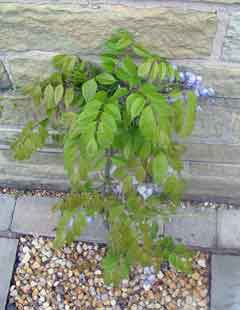
If you want your Wisteria to flower, start by buying a Wisteria plant in the spring that is in flower or has flower buds on it. That way, you know it can flower. The image left shows my small newly planted Wisteria with some small flowers on it. In 2007, this Wisteria was newly planted, and within 7 years it grew to 3.5m (around 12ft), and by 2018 it had covered the entire wall space at the back of the house. It is the same Wisteria featured in the video below, "Wonderful Wisteria". This is a testament to the vigorous nature of Wisteria and the need for longer (and longer) ladders to prune it. Hard to imagine this tiny plant grew to cover an entire wall of the house in 10 years.
Wisteria is best purchased as a grafted plant. You are likely to have problems with any plant grown from seed, which may be cheaper, but it may take a very long time to flower, as in more than a decade. You can spot a grafted plant as there is a bulge in the stem just above soil level in the plant pot. In the video below about summer pruning Wisteria at around 3min 40 sec, you can see the base of the Wisteria and the graft bulge.
When planting a new Wisteria, water it well and ensure that it does not dry out in the early stages. Once established, it will look after itself. Even in the drought of 2018 I did not water the wisteria, and it was fine. Wisteria is fully hardy, although frost can damage the emerging flowers (racemes)(see below) which means a sheltered spot is best. Wisteria can be grown as a standard if space is limited, which will involve careful pruning or select a smaller variety of Wisteria, such as Domino’ or Wisteria brachybotrys.
You can grow wisteria in a container, but with varying degrees of success. Recently, a friend asked me for advice about growing a Wisteria in a container, as the Wisteria had failed to flower. I suggested removing it from the container and replanting it in a sunny spot, and the following spring it flowered beautifully. Given the problems getting Wisteria to flower, growing it in a container adds a layer of difficulty.
How to prune Wisteria with Video advice
To make a wisteria flower, it is essential to prune regularly twice a year; a winter prune in February and summer prune in July/August. Hard pruning of wisteria is necessary; otherwise, it will produce vigorous leaf growth instead of flowers, resulting in few or no flowers.
Wisteria is vigorous and if not pruned regularly, it will quickly become rampant and outgrow its allotted space. In addition, plants need to be trained horizontally, which aids flowering.
If Wisteria is growing well, you may get a second flush of weaker flowers in late summer around August time. I find this causes a bit of a pruning dilemma, as those flowers can be just at the time of the summer prune, and I hate to cut them off. Delaying pruning by a couple of weeks will make no difference in the long term.
How to Make a Wisteria Flower
How to Winter Prune Wisteria
Wonderful Wisteria
How to Prune Wisteria - Winter Prune
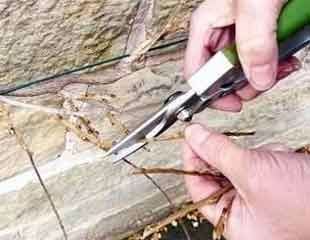
Pruning Wisteria can be daunting, so it's helpful to know that Wisteria is a very vigorous climbing plant and, thankfully, it is difficult to kill by pruning. Equally, you are unlikely to stop its flowering, providing you prune at the right times, which are February for the Winter prune and July/August for the summer. The one thing not to do when pruning a Wisteria is to cut into the hard woody mainframe of the plant.
In the winter prune, you are shortening the spurs, and in the summer prune removing leafy growth; two different types of pruning.
In some ways, the winter prune is easier because you can see the framework of the Wisteria. Winter pruning is best done in February, on a mild day. In the winter prune you need to cut the shoots back to 3/4 buds, reducing to 8/10 cms (3-4") Aim to leave the main plant framework in place and prune the shoots coming off the main frame work to encourage the formation of spurs.
How to prune Wisteria - Summer Prune
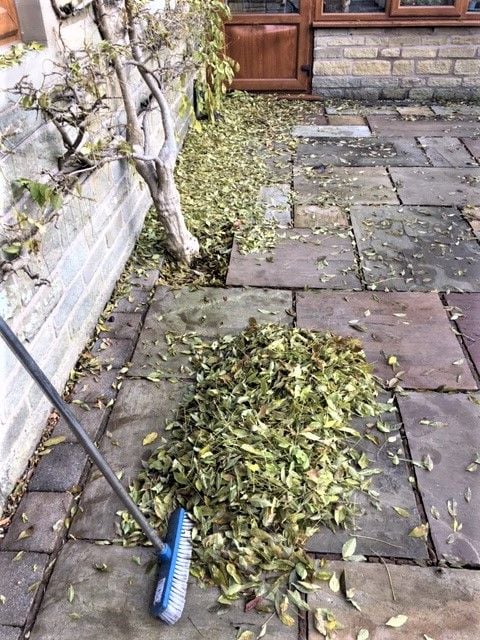
The summer pruning is just as essential, and it is best to prune hard. The purpose of the summer prune is to restrict and cut back the vigorous growth, so the plant will throw out new flower shoots in the spring. Viewing the main framework, and where you want the plant to grow, cut back and prune hard the long wippy (soft) growth to about 15cmc (6") Leave unpruned that which is needed for the framework.
You may need to cut off a lot of the long wippy growth and also cut off all laterals which appear at the base of the plant. These are shoots being thrown out at the base and remove all.
Thanks to Helen Yemm writing in her excellent gardening column, who remarked on the staining caused by Wisteria sap. It leaves brown marks on your clothes which nothing will shift. This makes it most important to be wearing your oldest gardening scruffs for this job.
A final small point on the time and maintenance required by Wisteria. It drops a lot of leaves in November and December, see image left, which also takes some maintenance clearing them up.
If after trying everything, pruning twice a year for a year or so, watering and feeding it still will not flower consider abandoning it and buying another. Write it off to experience .When planting your next Wisteria, make sure it is in a sunny, sheltered spot.
Where to see Wisteria
If you are thinking of growing Wisteria, this link has lots of images of Wisteria in varying settings. Planting a wisteria is quite an investment in terms of cost and gardening effort. Hopefully, the various pages of information and images will help you decide.
Also see problems with Wisteria for help with troubleshooting wisteria.
If you would like to see Wisteria in a garden setting, check out the National Garden Scheme Wisteria gardens. You can visit a local garden, enjoy beautiful gardens, and the modest entrance fees go to support nursing and cancer charities.
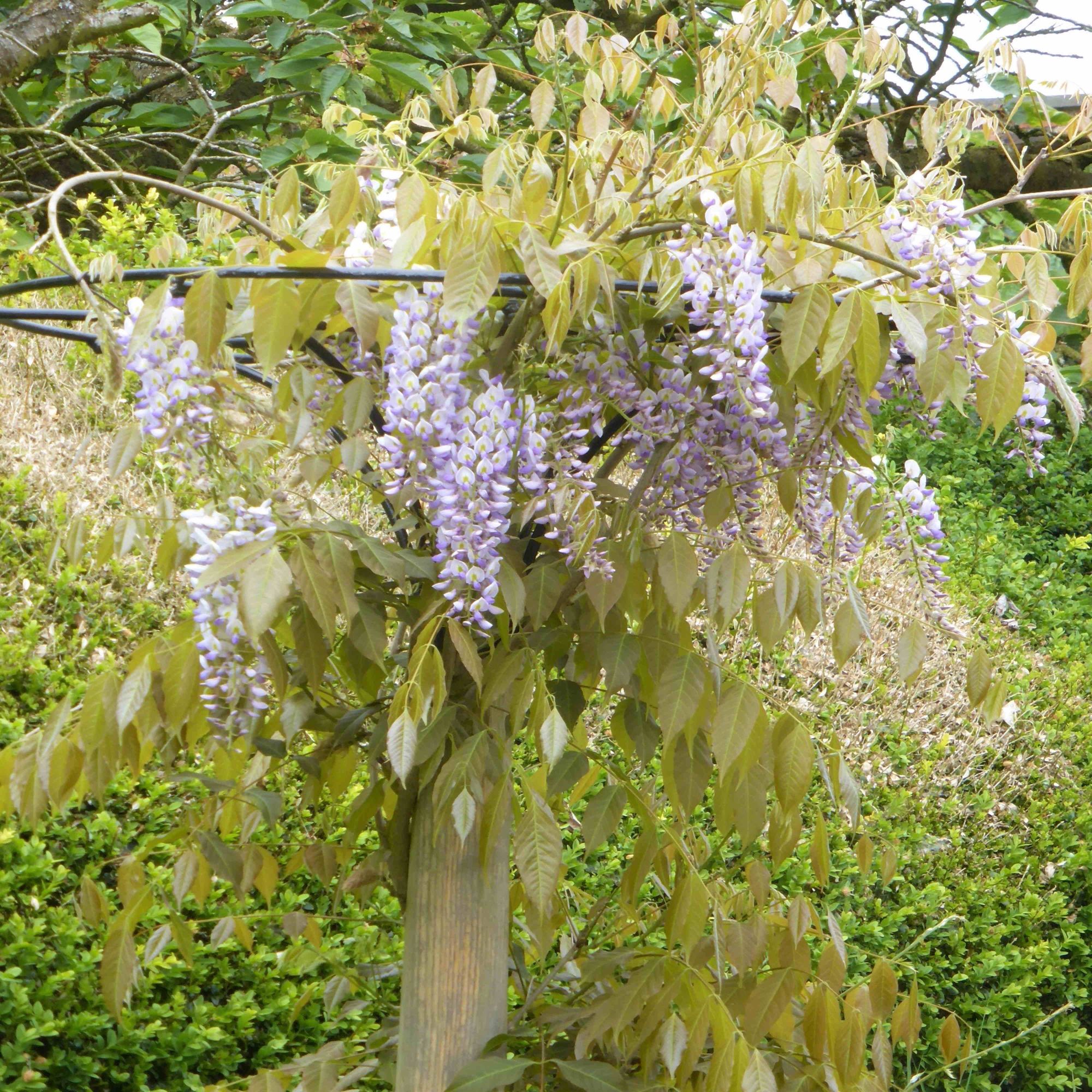
Growing Wisteria as a standard
One option if you want to grow Wisteria but do not fancy climbing up ladders to prune one solution is to train it as a standard.
It is best to start with a smaller, less vigorous variety of Wisteria. It is tempting to plant in a container, but Wisteria is more tricky to grow in a container, and it is better planted in a suitably sunny spot. I have used this image because it shows the hoop framework that is used to support the Wisteria and create the shape.

Illustrated here is another form of standard framework you could use to train Wisteria. Whichever type of frame is used, it demonstrates that Wisteria is more manageable as a standard.
This all ties into the need to prune Wisteria and how to access it easily. If it is not prune it will become a tangled mess, very large and vigorous and it will flower less and less over time. It is not essential to use a frame, but it supports the Wisteria can climb and the flower plumes dangle down. Train one main stem upwards and then allow stems to spread over the framework, or fan out naturally.
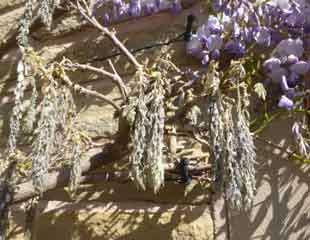
Frost damage
Frost can occasionally cause problems. The Wisteria shown in the left image has been growing and flowering happily for 10 years with no problems. However, the Spring of 2017 had unusual weather, mostly it was drier than usual, and often warm, which advanced the growing season. The Wisteria was in full bud by mid-April when there was an unusually cold spell with both ground and air frosts in many parts of the country. The winegrowers in the south of England reported 75% damage to their crop after temperatures dropped to -5.
Frost doesn't do Wisteria any good either, as the image left shows. Some buds went on to flower, but as illustrated in the image, other buds were damaged and did not flower. Wisteria is tough and it came the back next year. You can minimise frost damage by planting Wisteria in a sheltered spot.
